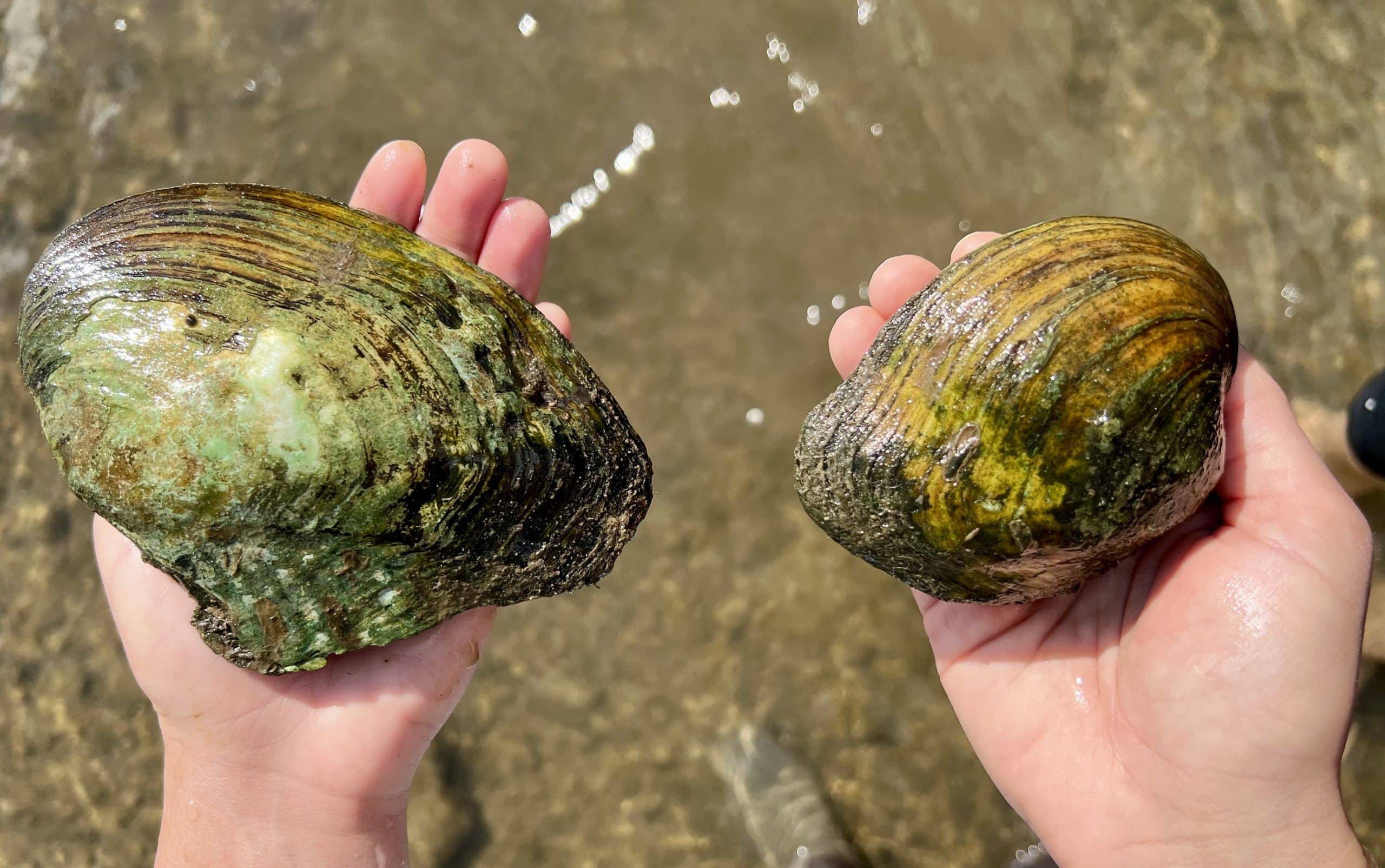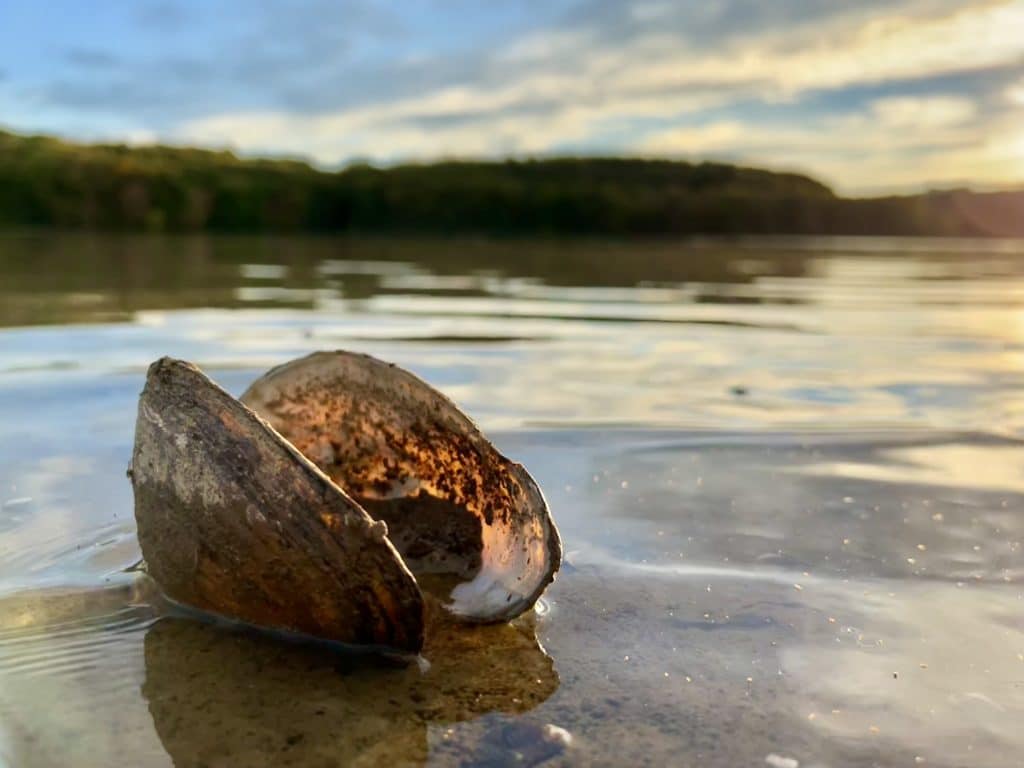Certain vulnerable species have become living symbols of conservation. Monarch butterflies grab the public eye with their brilliant colours, and beloved megafauna like the polar bear have rallied environmental support for decades. But the spotlight that shines on imperilled wildlife is not shared equally. Many lesser-known organisms are threatened by human activity and equally deserving of support. One such group is the unionids, or freshwater mussels.
—
Mussels are the unsung heroes of the freshwater world. These shy bivalves might not impress at first glance. They often go unnoticed, spending their lives hidden from sight at the bottoms of lakes, rivers, and streams. But do not be fooled by their unassuming nature – freshwater mussels are fascinating animals with their own unique charisma. They have wonderfully complex life cycles and play vital roles in maintaining healthy freshwater ecosystems.
Many species’ common names highlight their diverse colours and shapes. A single river may be home to elktoes, three-horn wartybacks, pink heelsplitters, and wavy-rayed lampmussels. Lucky waders may even stumble across the aptly-named Appalachian monkeyface mussel, a critically endangered species. With over 890 species worldwide, mussels are one of the most diverse groups of animals in the world. Unfortunately, they are also one of the most imperilled.
Why Do Freshwater Mussels Matter?
Mussels are ecosystem engineers, working around the clock to remove organic material and impurities from the water. It is a job that never stops. Embedded in the sediment, mussels continuously syphon bacteria, algae, and excess nutrients as they feed and breathe. With each mussel filtering around 10 gallons (37.8 litres) per day, it is also a job they do quite well. Large populations have powerful impacts on water quality: one study found that in a 300 mile (approximately 480 kilometre) stretch of the Mississippi River, mussels filter 14 billion gallons (53 billion litres) of water per day.
In an act of aquatic alchemy, mussels transform what they syphon into food for other organisms. They make essential contributions to nutrient cycling by breaking down compounds and excreting them as material that is more readily bio-assimilated. Where mussels go, others follow. Researchers in the UK found that greater mussel abundance predicted higher diversity among other freshwater organisms.

Freshwater mussels like the white heelsplitter (Lasmigona complanata, left) and mapleleaf mussel (Quadrula quadrula, right) keep water clean and play vital roles in healthy ecosystems. Photo by Logan Rance.
Beth Hollinden, a malacologist for a North American environmental consulting firm, discussed in an interview how mussels also function as biological indicators. “Mussels are like a canary in the coal mine,” she explained. “If you’ve got a big mussel die off, you can tell pretty much immediately that something is wrong and try to address that problem.”
Sudden mussel declines may point to issues like agricultural runoff or sedimentation. By monitoring mussel populations, researchers can simultaneously monitor the health of the surrounding ecosystem. Lately, these monitoring efforts reveal that mussels are struggling: in North America alone, populations have declined nearly 70%.
A Bizarre and Brilliant Reproductive Strategy
Even in a world of marsupial frogs and mate-eating mantises, mussels’ fascinating (and somewhat diabolical) reproductive methods set them apart. After a female syphons a male’s sperm from the open water, her eggs develop internally into microscopic larvae called glochidia. When it is time to leave mom behind, glochidia hitch a ride to a new location by attaching to the gills of an unsuspecting host fish. Glochidia remain attached for several weeks, tapping into nutrients present in their host’s gill tissue. They eventually drop off to the sediment where they continue growing into adults.
In order to help glochidia make the leap from mom to host, mussels have developed some creative methods for luring fish close. In some species, a female attracts hosts by dangling part of her mantle – the tissue that encloses the internal organs – that resembles a minnow or crayfish. Others bundle glochidia into a string of worm-like mucus packets and release the line into the water. When a prospective host bites a female’s lure, glochidia are released and latch on to the fish’s gills. Freshwater mussels in the genus Epioblasma take an even more shells-on approach: a female uses her exposed body to lure a fish close, then clamps on to its head and blasts it with a cloud of glochidia. When the deed is done, she releases the newly-infested host.
Up the Creek: Why Mussels are Threatened
While pawning off parental duties to fish is an incredible feat of evolution, this strategy makes mussels particularly vulnerable to environmental change.
“One of the biggest threats for mussels today is habitat fragmentation in the form of impoundments and dams,” said Hollinden. “This separates fish populations. If fish can’t travel up and down the stream you end up with isolated populations, and mussels can’t disperse.”
As more dams are constructed to meet growing demands for electricity, mussels and the fish who carry them face a difficult road ahead. Even protected watersheds are at risk: one 2020 study found that 1,200 dams existed in global protected areas, with 509 more planned for future construction.

A dead mussel sits just downstream from a construction site along Ohio’s Olentangy River. Photo by Logan Rance .
Dams are not mussels’ only upstream battle. As human activity floods waterways with heavy metals, pharmaceuticals and personal care products (PPCPs), fertilisers, and industrial waste, water quality is plummeting at an unprecedented rate. Despite powerful filtration abilities, mussels have limits to what they can syphon. With fewer environmental buffers like wetlands to sequester pollutants and minimise erosion, they are succumbing to poor water quality and sedimentation. Today, 45% of species worldwide are threatened with extinction or already extinct.
You might also like: Causes of Water Pollution And How We Can Reduce It
A Murky Future
Mussels are not only an essential part of today’s ecosystems – they are also a window into the past. Scientists study the geochemical makeup of their shells to learn about previous environmental conditions, and have even used them to research climate as far back as the Miocene era. Despite their long standing place in healthy freshwater habitats, they now face an uncertain future.
While mussels may not have the same support as other high-profile species, passionate researchers are working overtime to prevent them from disappearing for good. Some scientists are developing ways to grow mussels in labs and introduce them into restored habitats, with initial studies producing hopeful results. For malacologists like Hollinden, the fight for mussels is personal.
“Being able to contribute in whatever way to the preservation of this group of animals is very fulfilling,” she shared. “By doing things like relocations you can actively make a difference in the life of that animal.”
Relocations are an important part of protecting mussels from environmental disturbance. Feeling blindly along the bottoms of lakes and rivers, researchers collect mussels from areas at risk of being impacted by development (like in-water bridge construction) and move them to safer locations. Other work like habitat restoration, monitoring, and public outreach are vital to mussel conservation. Groups like Xerces Society for Invertebrate Conservation partner with researchers, tribes, and volunteers to restore mussel habitat and communicate the importance of mussels with the public.
Despite the best efforts of mussel-loving conservationists, the freshwater mussel faces difficult odds. Each species lost is a huge blow to water quality and biodiversity, leaving a hole in the ecosystem that is impossible to fill. Educating the public about mussels and the services they provide is essential to preserving their place in the world. While these humble filterers bring tremendous value to freshwater habitats, mussels deserve protection simply for being mussels. With their wonderfully weird lifecycles and robust biodiversity, they are among the most unique animals in the world. Mussels are well worth protecting and have earned a place in the spotlight. Time will tell if we can keep that spotlight from going out for good.
Featured image by Logan Rance
You might also like: The Benefits, Challenges of Protecting Oyster Reefs in Hong Kong


















